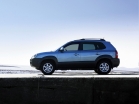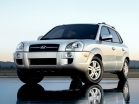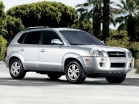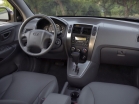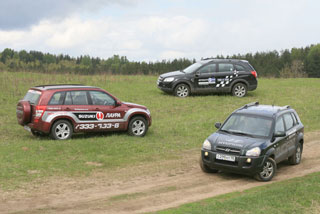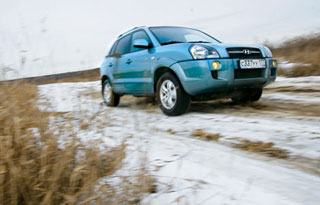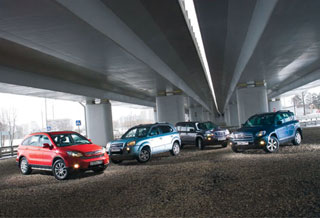Hyundai Tucson 2004 test drive - 2009 SUV
America is envious
 Last year, Hyundai Motor Co. I created a small sensation, selling more cars in Russia than any other foreign car manufacturer. The reason is not only the competent work of dealers, but also the attractive ratio of the price/quality of the company's products. In the ranking of the largest Hyundai automakers (along with KIA owned by it) is now in seventh place and intends to soon move to the fifth. Hyundai Tucson may well help her in this.
Last year, Hyundai Motor Co. I created a small sensation, selling more cars in Russia than any other foreign car manufacturer. The reason is not only the competent work of dealers, but also the attractive ratio of the price/quality of the company's products. In the ranking of the largest Hyundai automakers (along with KIA owned by it) is now in seventh place and intends to soon move to the fifth. Hyundai Tucson may well help her in this.  The European debut of the car took place in Geneva in the spring of 2004. The Americans saw it a month earlier, at a car dealership in Chicago. (America cannot be dispensed with - this is the main sales market Tucson, and its very name, as in the case of Hyundai Santa Fe, was borrowed from the city in the south -west of the United States.) Only a few months after the corresponding premieres, the car went on sale for sale All markets, including Russian. And he immediately got into a vast company of compact sports, including Toyota Rav4, Mitsubishi Outlander, Suzuki Grand Vitara, Nissan X-Trail, Honda Cr-V, Land Rover Freelander.
The European debut of the car took place in Geneva in the spring of 2004. The Americans saw it a month earlier, at a car dealership in Chicago. (America cannot be dispensed with - this is the main sales market Tucson, and its very name, as in the case of Hyundai Santa Fe, was borrowed from the city in the south -west of the United States.) Only a few months after the corresponding premieres, the car went on sale for sale All markets, including Russian. And he immediately got into a vast company of compact sports, including Toyota Rav4, Mitsubishi Outlander, Suzuki Grand Vitara, Nissan X-Trail, Honda Cr-V, Land Rover Freelander.  The company's desire to compete for the buyer in this sector is understandable: if the total increase in the sales of the world auto industry is predicted at 3.3% in the next four years, then for compact SUVs it can be 6.6% - twice as much. So what can Hyundai Tucson contrast with its competitors?
The company's desire to compete for the buyer in this sector is understandable: if the total increase in the sales of the world auto industry is predicted at 3.3% in the next four years, then for compact SUVs it can be 6.6% - twice as much. So what can Hyundai Tucson contrast with its competitors? Like almost all the compact SUV recent times, Tucson looks more likely light than in-date-according to fashion for body crossovers. A sort of perirable hatchback turned out. Moreover, five -door (many rivals of doors have only three). There are features of a larger Santa Fe in the appearance, but in a muffled form, which has a beneficial effect on overall attractiveness. The body is bearing, the platform, of course, the passenger - is borrowed from the Elantra sedan, but strengthened and elongated.
 Spacious interior: 180 mm Tucson is shorter than Santa Fe, but it has 10 mm more wheelbase. The seats are quite tough, there is even some side support. In general, sitting is convenient. The landing is high, while above my head (at my 185 cm of growth) there was a decent supply - ten or twelve centimeters.
Spacious interior: 180 mm Tucson is shorter than Santa Fe, but it has 10 mm more wheelbase. The seats are quite tough, there is even some side support. In general, sitting is convenient. The landing is high, while above my head (at my 185 cm of growth) there was a decent supply - ten or twelve centimeters. The front racks were initially embarrassed by their massiveness. But, as it turned out, their location and angle of inclination of the windshield are selected so as not to interfere with the review. And not even a tent (162 cm - specially checked) the driver does not have to pull the neck. High landing and a large area of \u200b\u200bglass create the illusion that you are sitting in the cinema and looking at the screen from which the road rolls on you. This impression instantly disappears as soon as you look at the rear -view mirror - due to the strong inclination of the windshield, it is unexpectedly close. The size of the mirror is correct, it reflects only what can be seen through the glass of the rear door - nothing superfluous (the head restraints do not interfere). But only roofs remain from close passenger cars, and one Oka almost managed to completely hide. Almost - because Parktronic (option) reacted to it. There are no complaints about large lateral mirrors.
 The steering wheel is thick, quite convenient (especially if you steer gloves). Devices and controls are located logically, everything is in sight and it is not necessary to reach anywhere. The salon is assembled carefully. The materials, however, are from inexpensive (we will be polite) - luxury and does not smell. But inside it is quite comfortable, while everything is quite functional. Here, for example, is surprisingly spacious rear seats - they can be folded with one hand, while an even horizontal surface is really formed (many promise this, but not everyone does). The secret is that when overturning the back forward, the seat pillow goes down. Of the pleasant little things: the glass of the rear door can open separately, and on the door there is a comfortable handle for closing it. And all sorts of hooks and containers in the cabin, mesh in the luggage compartment ...
The steering wheel is thick, quite convenient (especially if you steer gloves). Devices and controls are located logically, everything is in sight and it is not necessary to reach anywhere. The salon is assembled carefully. The materials, however, are from inexpensive (we will be polite) - luxury and does not smell. But inside it is quite comfortable, while everything is quite functional. Here, for example, is surprisingly spacious rear seats - they can be folded with one hand, while an even horizontal surface is really formed (many promise this, but not everyone does). The secret is that when overturning the back forward, the seat pillow goes down. Of the pleasant little things: the glass of the rear door can open separately, and on the door there is a comfortable handle for closing it. And all sorts of hooks and containers in the cabin, mesh in the luggage compartment ... Three engines are provided for Tucson - diesel and two gasoline. The diesel engine is not delivered to Russia: the company does not want our diesel fuel to destroy its motors - this would give a shadow to the reputation of Hyundai. Gasoline-please: 2-liter four with a cast-iron block (142 hp) or a 2.7-liter aluminum engine V6 with a capacity of 175 hp. They (complete with a N-Matic automaton) and was equipped with a car taken for a test ...
 Frankly say: the 2.7-liter engine of the Tucson missile does not. But with three passengers, he wins the start of many cars, and gets to hundreds of seconds in eleven. The speed set goes calmly, evenly, on a good highway, the car easily makes 160 km/h, and even a small supply remains. This is if at the start to drown the gas pedal on the floor and not let it go anymore. And if you get to 70-80 km/h, go to the movement of the roll, and then try to accelerate sharply, then ... it will not work - the machine will think too long before turning on the desired gear. You can forgive it, there are only four steps. But this feature is worth taking into account - before starting overtaking on a narrow highway.
Frankly say: the 2.7-liter engine of the Tucson missile does not. But with three passengers, he wins the start of many cars, and gets to hundreds of seconds in eleven. The speed set goes calmly, evenly, on a good highway, the car easily makes 160 km/h, and even a small supply remains. This is if at the start to drown the gas pedal on the floor and not let it go anymore. And if you get to 70-80 km/h, go to the movement of the roll, and then try to accelerate sharply, then ... it will not work - the machine will think too long before turning on the desired gear. You can forgive it, there are only four steps. But this feature is worth taking into account - before starting overtaking on a narrow highway.  The cars supplied to Russia do not constructively differ from those that are sold in other markets: they did not strengthen the suspension and did not increase the clearance (most often the officially declared alterations for Russia are limited). There are differences only in the configuration: the diesel mentioned above, for example. Or the Borg -Warner full -wheel drive system - in other Tucson markets, it is an option, and we only have this. The thing is theoretically useful: it distributes the torque between the wheels by need. On a good dry coating, almost 100% of the available reserve of Newton meters are supplied to the front axle. As soon as the system sensors determine the slippage of the front wheels, part of the moment (up to 50%) is immediately sent back. At the same time - according to the branded description - the angle of rotation of the steering wheel and the speed of moving the gas pedal (as well as the magnitude of the electrostatic charge of the cat’s wool that lives by the Vacer Stalis Watch - this is from the editorial office) will be taken into account. On the dashboard is the 4WD button, which allows you to block the transmission, while the torque is distributed between the axes equally.
The cars supplied to Russia do not constructively differ from those that are sold in other markets: they did not strengthen the suspension and did not increase the clearance (most often the officially declared alterations for Russia are limited). There are differences only in the configuration: the diesel mentioned above, for example. Or the Borg -Warner full -wheel drive system - in other Tucson markets, it is an option, and we only have this. The thing is theoretically useful: it distributes the torque between the wheels by need. On a good dry coating, almost 100% of the available reserve of Newton meters are supplied to the front axle. As soon as the system sensors determine the slippage of the front wheels, part of the moment (up to 50%) is immediately sent back. At the same time - according to the branded description - the angle of rotation of the steering wheel and the speed of moving the gas pedal (as well as the magnitude of the electrostatic charge of the cat’s wool that lives by the Vacer Stalis Watch - this is from the editorial office) will be taken into account. On the dashboard is the 4WD button, which allows you to block the transmission, while the torque is distributed between the axes equally.  Theoretically, the advantages of such a system are not in doubt, especially since it has already been successfully tested on Acura MDX, a luxury version of an ideologically similar apparatus from Honda. It is called Itm-I (Inter Active Torue Management). And practically? If we rolled Tucson in snow and ice, the results could be different, but it was in the fall, besides in dry weather. They tried in every way: they spun on moist grass, on dusty clay - the car never lost the trajectory and did not go to the yuz, no matter how we tried. There is no indication of ITM-I work, so you can catch the moment of its inclusion only the fifth point, and this is not easy.
Theoretically, the advantages of such a system are not in doubt, especially since it has already been successfully tested on Acura MDX, a luxury version of an ideologically similar apparatus from Honda. It is called Itm-I (Inter Active Torue Management). And practically? If we rolled Tucson in snow and ice, the results could be different, but it was in the fall, besides in dry weather. They tried in every way: they spun on moist grass, on dusty clay - the car never lost the trajectory and did not go to the yuz, no matter how we tried. There is no indication of ITM-I work, so you can catch the moment of its inclusion only the fifth point, and this is not easy. The suspension is successful. Macpherson in front, independent from behind, there are reptile stability stabilizers, everything is collected on subframes. The car is perfectly uneven, does not lose a course on the transverse waves of the coating. The energy intensity is good - moving through a standard rubberized policeman at a speed of 30 km/h does not bring almost any sensations. There is no tank of the body, the rolls are small. The suspension is slightly harsh on small irregularities (paving stones, grader, traces of a caterpillar tractor in dried clay), but it provides stability in corners. The steering wheel is light (3.1 turns), good when parking, but a little empty at speed. Although the class and purpose of the car are quite consistent. Brakes (disk on all wheels) work perfectly ...
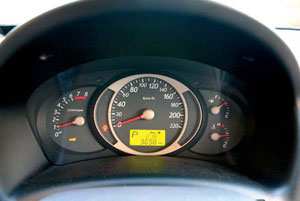 We give a squeeze from the Hyundai press release. Creating Tucson, the company sought to take into account the tastes of both the male and female part of potential buyers. Focus group - active young (25 with small) people oriented to career growth. At the same time, Tucson is not the second car in the family, but the first, therefore it is so universal and functional.
We give a squeeze from the Hyundai press release. Creating Tucson, the company sought to take into account the tastes of both the male and female part of potential buyers. Focus group - active young (25 with small) people oriented to career growth. At the same time, Tucson is not the second car in the family, but the first, therefore it is so universal and functional. 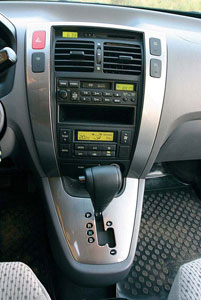 It looks like the truth. Tucson is a car for a not too rich part of American buyers. And, like any mass model - a budget product. They saved on a lot (on the surface: the plastic of the interior decoration, the old -fashioned ignition key with a separate keychain, instead of gas springs of the hood support - a short poker, to which you need to reach over a burning hot engine ...). But in general, it turned out well. By the way, TUCSON is only in rich countries. In the United States, for example, its price, depending on the configuration, fits in the range of $ 17,000-22,000. In the UK, where cars for cars are very high, the fork is 15,000-18,700 pounds. And what? But please: $ 25.990-32.490. But they take it! At the end of last year, 200 cars a month took. They would sell more, but there is a supplies limit. That's what our country is - America to envy!
It looks like the truth. Tucson is a car for a not too rich part of American buyers. And, like any mass model - a budget product. They saved on a lot (on the surface: the plastic of the interior decoration, the old -fashioned ignition key with a separate keychain, instead of gas springs of the hood support - a short poker, to which you need to reach over a burning hot engine ...). But in general, it turned out well. By the way, TUCSON is only in rich countries. In the United States, for example, its price, depending on the configuration, fits in the range of $ 17,000-22,000. In the UK, where cars for cars are very high, the fork is 15,000-18,700 pounds. And what? But please: $ 25.990-32.490. But they take it! At the end of last year, 200 cars a month took. They would sell more, but there is a supplies limit. That's what our country is - America to envy! Text: George Zverev
A source: Motor magazine [No. 03/2005]
Hyundai Tucson 2004 Video Video - 2009
Hyundai Tucson 2004 - 2009 Crash Video.
Hyundai Tucson 2004 test drives - 2009
Hyundai Tucson 2004 Krash Test - 2009
Krassh Test: Detailed Information29%
Driver and passengers
4%
Pedestrians
32%
Children-passengers
Hyundai Tucson 2004 malfunctions - 2009
Hyundai IX35 (TUCSON) malfunctions: Detailed information| TUCSON 2004 - 2009 | |
|---|---|
| Engine |  |
| Transmission |  |
| Control system and suspension |  |
| Brake system |  |
| Air heating and air conditioning |  |
| Launch and charging system |  |
| Electric components and so on |  |
| Corrosion body stability |  |

